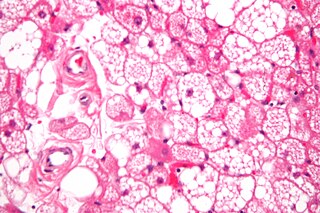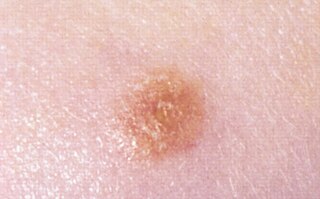| Spindle cell lipoma | |
|---|---|
 |
Spindle cell lipoma is an asymptomatic, slow-growing subcutaneous tumor that has a predilection for the posterior back, neck, and shoulders of older men. [1] :625 [2]
| Spindle cell lipoma | |
|---|---|
 |
Spindle cell lipoma is an asymptomatic, slow-growing subcutaneous tumor that has a predilection for the posterior back, neck, and shoulders of older men. [1] :625 [2]

A lipoma is a benign tumor made of fat tissue. They are generally soft to the touch, movable, and painless. They usually occur just under the skin, but occasionally may be deeper. Most are less than 5 cm in size. Common locations include upper back, shoulders, and abdomen. A few people have a number of lipomas.

Phosphatidylcholines (PC) are a class of phospholipids that incorporate choline as a headgroup. They are a major component of biological membranes and can be easily obtained from a variety of readily available sources, such as egg yolk or soybeans, from which they are mechanically or chemically extracted using hexane. They are also a member of the lecithin group of yellow-brownish fatty substances occurring in animal and plant tissues. Dipalmitoyl phosphatidylcholine is a major component of pulmonary surfactant and is often used in the L/S ratio to calculate fetal lung maturity. While phosphatidylcholines are found in all plant and animal cells, they are absent in the membranes of most bacteria, including Escherichia coli. Purified phosphatidylcholine is produced commercially.

Nevus is a nonspecific medical term for a visible, circumscribed, chronic lesion of the skin or mucosa. The term originates from nævus, which is Latin for "birthmark"; however, a nevus can be either congenital or acquired. Common terms, including mole, birthmark, and beauty mark, are used to describe nevi, but these terms do not distinguish specific types of nevi from one another.

Dermatofibrosarcoma protuberans (DFSP) is a rare locally aggressive malignant cutaneous soft-tissue sarcoma. DFSP develops in the connective tissue cells in the middle layer of the skin (dermis). Estimates of the overall occurrence of DFSP in the United States are 0.8 to 4.5 cases per million persons per year. In the United States, DFSP accounts for between 1 and 6 percent of all soft tissue sarcomas and 18 percent of all cutaneous soft tissue sarcomas. In the Surveillance, Epidemiology and End Results (SEER) tumor registry from 1992 through 2004, DFSP was second only to Kaposi sarcoma.
The International Classification of Diseases for Oncology (ICD-O) is a domain-specific extension of the International Statistical Classification of Diseases and Related Health Problems for tumor diseases. This classification is widely used by cancer registries.

Angiolipoma is a subcutaneous nodule with vascular structure, having all other features of a typical lipoma. They are commonly painful.

A hibernoma is a benign neoplasm of vestigial brown fat. The term was originally used by Gery in 1914.
Neural fibrolipoma is an overgrowth of fibro-fatty tissue along a nerve trunk that often leads to nerve compression.
Chondroid lipomas are deep-seated, firm, yellow tumors that characteristically occur on the legs of women. They exhibit a characteristic translocation t(11;16) with a resulting C11orf95-MKL2 fusion oncogene.
Pleomorphic lipomas, like spindle-cell lipomas, occur for the most part on the backs and necks of elderly men, and are characterized by floret giant cells with overlapping nuclei.
Intradermal spindle cell lipoma is distinct in that it most commonly affects women, and has a wide distribution, occurring with relatively equal frequency on the head and neck, trunk, and upper and lower extremities.
Erosive pustular dermatitis of the scalp presents with pustules, erosions, and crusts on the scalp of primarily older Caucasian females, and on biopsy, has a lymphoplasmacytic infiltrate with or without foreign body giant cells and pilosebaceous atrophy.

A Spitz nevus is a benign skin lesion. A type of melanocytic nevus, it affects the epidermis and dermis.

Fibroma of tendon sheath is a benign tumor that presents as a small subcutaneous nodule that slowly increases in size. The tumors often have a multinodular growth pattern, with individual nodules being composed of bland, slender, spindle-shaped cells (myofibroblasts) in a dense, fibrous matrix.” A common microscopic finding is the presence of elongated, slit-like blood vessels. The lesions nearly always arise in the distal portions of the extremities. They often occur on the fingers, hands, toes, or feet. Although they are benign, they may recur in up to 40% of cases.

A pigmented spindle cell nevus is a skin condition characterized by a dark brown to black macule or papule, usually less than 6 mm.

Pleomorphic fibromas of the skin usually present in adults, with a slight preponderance in women.
Hemihyperplasia–multiple lipomatosis syndrome is a cutaneous condition characterized by multiple lipomas in association with asymmetric overgrowth, cutaneous capillary malformations, and thickened plantar skin with prominent creases.

Mammary myofibroblastoma (MMFB) is a rare, benign tumor of the breast.
Epithelioid cell histiocytoma is a rare skin condition that is considered to be a variant of a dermatofibroma.
| Classification |
|
|---|
| This Dermal and subcutaneous growths article is a stub. You can help Wikipedia by expanding it. |